FBG Spectrum Regeneration by Ni-Coating and High-Temperature Treatment
Abstract
1. Introduction
2. Materials and Methods
2.1. Preparation of the Ni-Coated Sensor
2.2. Thermal Recovery and Cycling Treatment
3. Results and Discussion
3.1. Analysis of the Spectrum during Gilding, Electrodeposition, and Thermal Recovery
3.2. High-Thermal Cycling
3.3. Thermal Cycle for CWL Stabilization
4. Conclusions
Author Contributions
Funding
Institutional Review Board Statement
Informed Consent Statement
Data Availability Statement
Conflicts of Interest
References
- Cheng, P.; Wang, L.; Pan, Y.; Yan, H.; Gao, D.; Wang, J.; Zhang, H. Fiber Bragg grating temperature sensor of cladding with SrTiO3 thin film by pulsed laser deposition. Laser Phys. 2019, 29, 025107. [Google Scholar] [CrossRef]
- Daud, S.; Rohizad, S.N.A.; Noordin, A.F.A.; Yupapin, P.; Amiri, I.S. Temperature Sensing with Fibre Bragg Grating and No-Core Fibre. Natl. Acad. Sci. Lett. 2021, 44, 405–407. [Google Scholar] [CrossRef]
- Juraszek, J.; Antonik-Popiołek, P. Fibre optic fbg sensors for monitoring of the temperature of the building envelope. Materials 2021, 14, 1207. [Google Scholar] [CrossRef] [PubMed]
- Xiang, Z.; Wan, L.; Gong, Z.; Zhou, Z.; Ma, Z.; OuYang, X.; He, Z.; Chan, C.C. Multifunctional textile platform for fiber optic wearable temperature-monitoring application. Micromachines 2019, 10, 866. [Google Scholar] [CrossRef]
- Ghorat, M.; Gharehpetian, G.B.; Latifi, H.; Hejazi, M.A.; Bagheri, M. High-resolution FBG-based fiber-optic sensor with temperature compensation for PD monitoring. Sensors 2019, 19, 5285. [Google Scholar] [CrossRef] [PubMed]
- Ran, Y.; Feng, F.-R.; Liang, Y.-Z.; Jin, L.; Guan, B.-O. Type IIa Bragg grating based ultra-short DBR fiber laser with high temperature resistance. Opt. Lett. 2015, 40, 5706. [Google Scholar] [CrossRef]
- Prakash, O.; Kumar, J.; Mahakud, R.; Agrawal, S.K.; Dixit, S.K.; Nakhe, S.V. Enhanced temperature (~800 °C) stability of type-IIa FBG written by 255 nm beam. IEEE Photonics Technol. Lett. 2014, 26, 93–95. [Google Scholar] [CrossRef]
- Polz, L.; Dutz, F.J.; Maier, R.R.J.; Bartelt, H.; Roths, J. Regenerated Fibre Bragg Gratings: A critical assessment of more than 20 years of investigations. Opt. Laser Technol. 2021, 134, 106650. [Google Scholar] [CrossRef]
- Canning, J. Regeneration, regenerated gratings and composite glass properties: The implications for high temperature micro and nano milling and optical sensing. Meas. J. Int. Meas. Confed. 2016, 79, 236–249. [Google Scholar] [CrossRef]
- Brambilla, G.; Rutt, H. Fiber Bragg gratings with enhanced thermal stability. Appl. Phys. Lett. 2002, 80, 3259. [Google Scholar] [CrossRef]
- Canning, J. Fibre gratings and devices for sensors and laser. Laser Photonics Rev. 2008, 2, 275–289. [Google Scholar] [CrossRef]
- Fokine, M. Thermal stability of chemical composition gratings in fluorine-germanium-doped silica fibers. Opt. Lett. 2002, 27, 1016–1018. [Google Scholar] [CrossRef] [PubMed]
- Xia, H. Advanced Fiber Optical Sensor and Instrumentation for Power Generation Industrial Monitoring and Diagnostics. In Proceedings of the SPIE Fiber Optic Sensors and Applications IX, Baltimore, MD, USA, 4 May 2012; Volume 8370, pp. 1–10. [Google Scholar]
- Xia, H.; McCarthy, K.T.; Deng, K.-L.J.; Lopez, F.J.; Avagliano, A.J. Fiber Bragg Grating for High Temperature Sensing. U.S. Patent No. 7,499,605, 3 March 2009. [Google Scholar]
- Lindner, E.; Canning, J.; Chojetzki, C.; Brückner, S.; Becker, M.; Rothhardt, M.; Bartelt, H. Thermal regenerated type IIa fiber Bragg gratings for ultra-high temperature operation. OPTICS 2011, 284, 183–185. [Google Scholar] [CrossRef]
- Yang, H.Z.; Qiao, X.G.; Das, S.; Paul, M.C. Thermal regenerated grating operation at temperatures up to 1400°C using new class of multimaterial glass-based photosensitive fiber. Opt. Lett. 2014, 39, 6438. [Google Scholar] [CrossRef] [PubMed]
- Groothoff, N.; Canning, J. Enhanced type IIA gratings for high-temperature operation. Opt. Lett. 2004, 29, 2360–2362. [Google Scholar] [CrossRef]
- Åslund, M.L.; Canning, J.; Stevenson, M.; Cook, K. Thermal stabilization of Type I fiber Bragg gratings for operation up to 600 °C. Opt. Lett. 2010, 35, 586. [Google Scholar] [CrossRef] [PubMed]
- Holmberg, P.; Laurell, F.; Fokine, M. Influence of pre-annealing on the thermal regeneration of fiber Bragg gratings in standard optical fibers. Opt. Express 2015, 23, 27520. [Google Scholar] [CrossRef] [PubMed]
- Li, Y.; Yang, K.; Li, X. Temperature sensing characteristics of metal coated FBG during dynamic cooling process. Opt. Fiber Technol. 2018, 45, 368–375. [Google Scholar] [CrossRef]
- Raghuwanshi, S.K.; Palodiya, V. Beam propagation and mode coupling study in a coupled waveguide structure by using scalar finite element method. Optik 2016, 127, 1237–1244. [Google Scholar] [CrossRef]
- Tahhan, S.R.; Ali, M.H.; Al-Ogaidi, M.A.Z.; Abass, A.K. Impact of apodization profile on performance of fiber bragg grating strain–temperature sensor. J. Commun. 2019, 14, 53–57. [Google Scholar] [CrossRef]
- Saktioto, T.; Ramadhan, K.; Soerbakti, Y.; Irawan, D.; Okfalisa. Integration of chirping and apodization of Topas materials for improving the performance of fiber Bragg grating sensors. J. Phys. Conf. Ser. 2021, 2049, 012001. [Google Scholar] [CrossRef]
- Mesa Yandy, A.M.; Duchowicz, R.; Russo, N.A.; Cruz, J.L.; Andrés, M.V. Development and analysis of a model based on chirped fiber Bragg gratings employed for cracks characterization in materials. Opt. Commun. 2018, 426, 401–409. [Google Scholar] [CrossRef]
- Vendittozzi, C.; Felli, F.; Lupi, C. Modeling FBG sensors sensitivity from cryogenic temperatures to room temperature as a function of metal coating thickness. Opt. Fiber Technol. 2018, 42, 84–91. [Google Scholar] [CrossRef]
- Ross, M.J.; Jenkins, R.B.; Nelson, C.; Joyce, P. High temperature effects during high energy laser strikes on embedded fiber bragg grating sensors. Sensors 2019, 19, 1432. [Google Scholar] [CrossRef] [PubMed]
- Li, Y.; Wen, C.; Zhang, H.; Yang, J.; Yan, M.; Jiang, J. An electroplating method for surface mounting optical fiber sensors on the metal substrate. IEEE Photonics Technol. Lett. 2016, 28, 1811–1814. [Google Scholar] [CrossRef]
- Li, C.; Yang, W.; Wang, M.; Yu, X.; Fan, J.; Xiong, Y.; Yang, Y.; Li, L. A review of coating materials used to improve the performance of optical fiber sensors. Sensors 2020, 20, 4215. [Google Scholar] [CrossRef]
- Lupi, C.; Felli, F.; Ciro, E.; Paris, C.; Vendittozzi, C. Railway overhead contact wire monitoring system by means of FBG sensor. Frat. Ed Integrità Strutt. 2021, 57, 246–258. [Google Scholar] [CrossRef]
- Koo, K.N.; Ismail, A.F.; Othman, M.H.D.; Samavati, A.; Tai, Z.S.; Rahman, M.A.; Bakhtiar, H.; Aizi Mat, M. Fabrication and modification of temperature FBG sensor: Role of optical fiber type and Cu sputtered thickness. Phys. Scr. 2020, 95, 095509. [Google Scholar] [CrossRef]
- Mansor, N.F.; Raja Ibrahim, R.K. Temperature sensitivity of FBG coating with zinc oxide and silicon carbide. J. Phys. Conf. Ser. 2021, 1892, 012033. [Google Scholar] [CrossRef]
- Rosolem, J.B.; Penze, R.S.; Bassan, F.R.; Floridia, C.; Peres, R.; Dini, D.C.; Vasconcelos, D.; Junior, M.A.R. Electroless Nickel-Plating Sealing in FBG Pressure Sensor for Thermoelectric Power Plant Engines Applications. J. Light. Technol. 2019, 37, 4791–4798. [Google Scholar] [CrossRef]
- He, J.; Ding, L.; Cai, J.; Zhu, W.; Dai, J. A novel high temperature resistant Mo-Cu functional gradient coating for optic fiber Bragg grating. Results Phys. 2019, 14, 102456. [Google Scholar] [CrossRef]
- Lupi, C.; Felli, F.; Dell’Era, A.; Ciro, E.; Caponero, M.A.; Kalinowski, H.J.; Vendittozzi, C. Critical Issues of Double-Metal Layer Coating on FBG for Applications at High Temperatures. Sens. Artic. 2019, 19, 3824. [Google Scholar] [CrossRef] [PubMed]
- Grandal, T.; Zornoza, A.; Lopez, A.; Fraga, S.; Sun, T.; Grattan, K.T.V. Analysis of fiber optic sensor embedded in metals by automatic and manual tig welding. IEEE Sens. J. 2019, 19, 7425–7433. [Google Scholar] [CrossRef]
- Lupi, C.; Felli, F.; Ippoliti, L.; Caponero, M.A.; Ciotti, M.; Nardelli, V.; Paolozzi, A. Metal coating for enhancing the sensitivity of fibre Bragg grating sensors at cryogenic temperature. Smart Mater. Struct. 2005, 14, N71. [Google Scholar] [CrossRef]
- Rajini-Kumar, R.; Suesser, M.; Narayankhedkar, K.G.; Krieg, G.; Atrey, M.D. Performance evaluation of metal-coated fiber Bragg grating sensors for sensing cryogenic temperature. Cryogenics 2008, 48, 142–147. [Google Scholar] [CrossRef]
- Hsu, C.Y.; Chiang, C.C.; Hsieh, T.S.; Hsu, H.C.; Tsai, L.; Hou, C.H. Study of fiber Bragg gratings with TiN-coated for cryogenic temperature measurement. Opt. Laser Technol. 2021, 136, 106768. [Google Scholar] [CrossRef]
- Rao, C.; Zhang, H.; Feng, Y.; Xiao, L.; Ye, Z. Effect of metalizing nickel on the spectrum of fiber Bragg grating. Opt. Eng. 2013, 52, 054404. [Google Scholar] [CrossRef]
- Liang, Z.; Ahn, H.S.; Bard, A.J. A Study of the Mechanism of the Hydrogen Evolution Reaction on Nickel by Surface Interrogation Scanning Electrochemical Microscopy. J. Am. Chem. Soc. 2017, 139, 4854–4858. [Google Scholar] [CrossRef]
- Tamm, J.; Tamm, L.; Arol’d, J. Cathodic hydrogen evolution on nickel in acidic environment. Russ. J. Electrochem. 2004, 40, 1152–1155. [Google Scholar] [CrossRef]
- Adamovsky, G.; Lyuksyutov, S.F.; MacKey, J.R.; Floyd, B.M.; Abeywickrema, U.; Fedin, I.; Rackaitis, M. Peculiarities of thermo-optic coefficient under different temperature regimes in optical fibers containing fiber Bragg gratings. Opt. Commun. 2012, 285, 766–773. [Google Scholar] [CrossRef]
- Yin, J.; Zhu, H.; Ke, L.; Hu, P.; He, C.; Zhang, H.; Zeng, X. A finite element model of thermal evolution in laser micro sintering. Int. J. Adv. Manuf. Technol. 2016, 83, 1847–1859. [Google Scholar] [CrossRef]
- Zhang, J.; Korzhavyi, P.A. First principles investigation on thermodynamic properties and stacking fault energy of paramagnetic nickel at high temperatures. Metals 2020, 10, 319. [Google Scholar] [CrossRef]
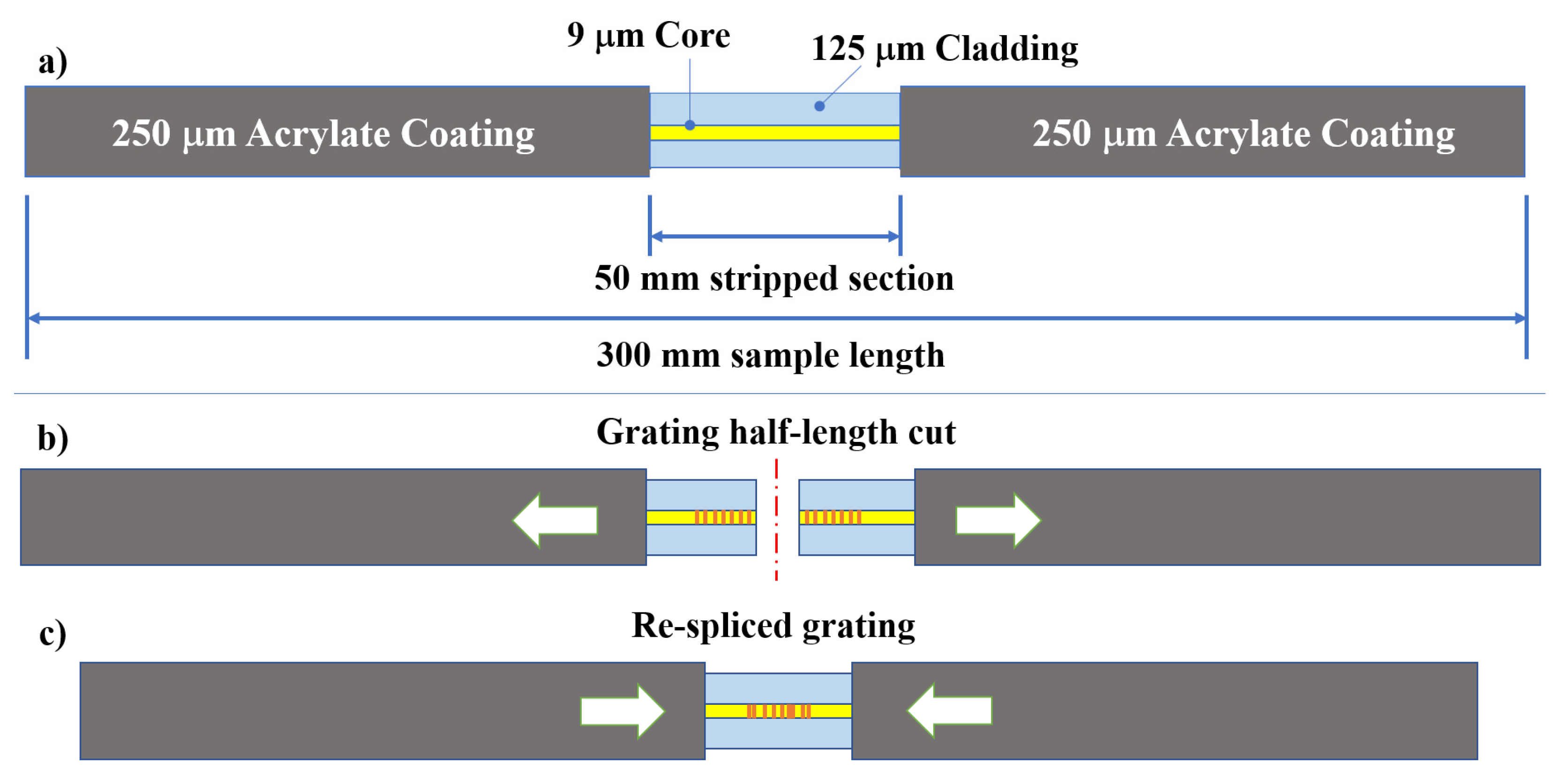
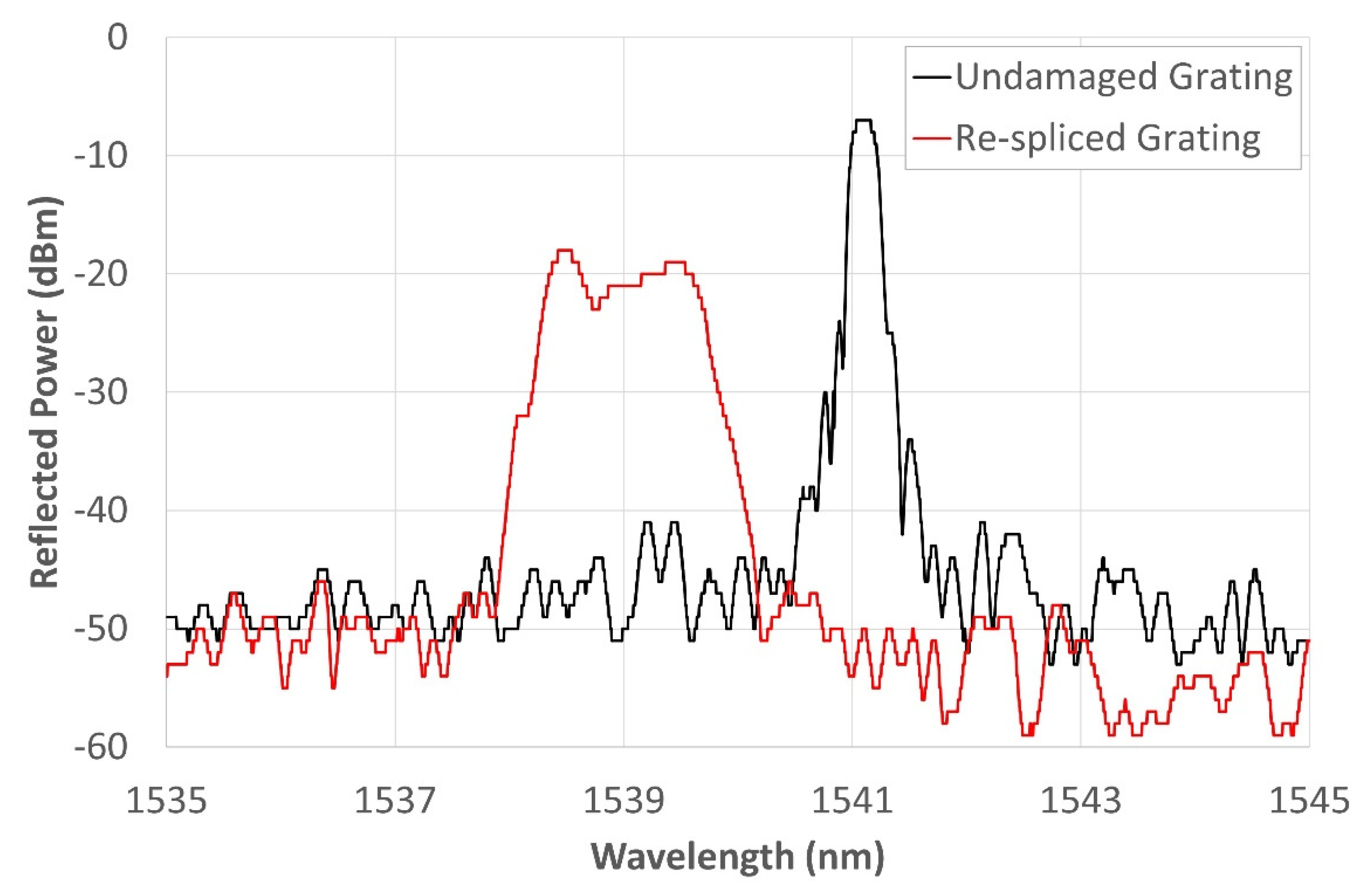
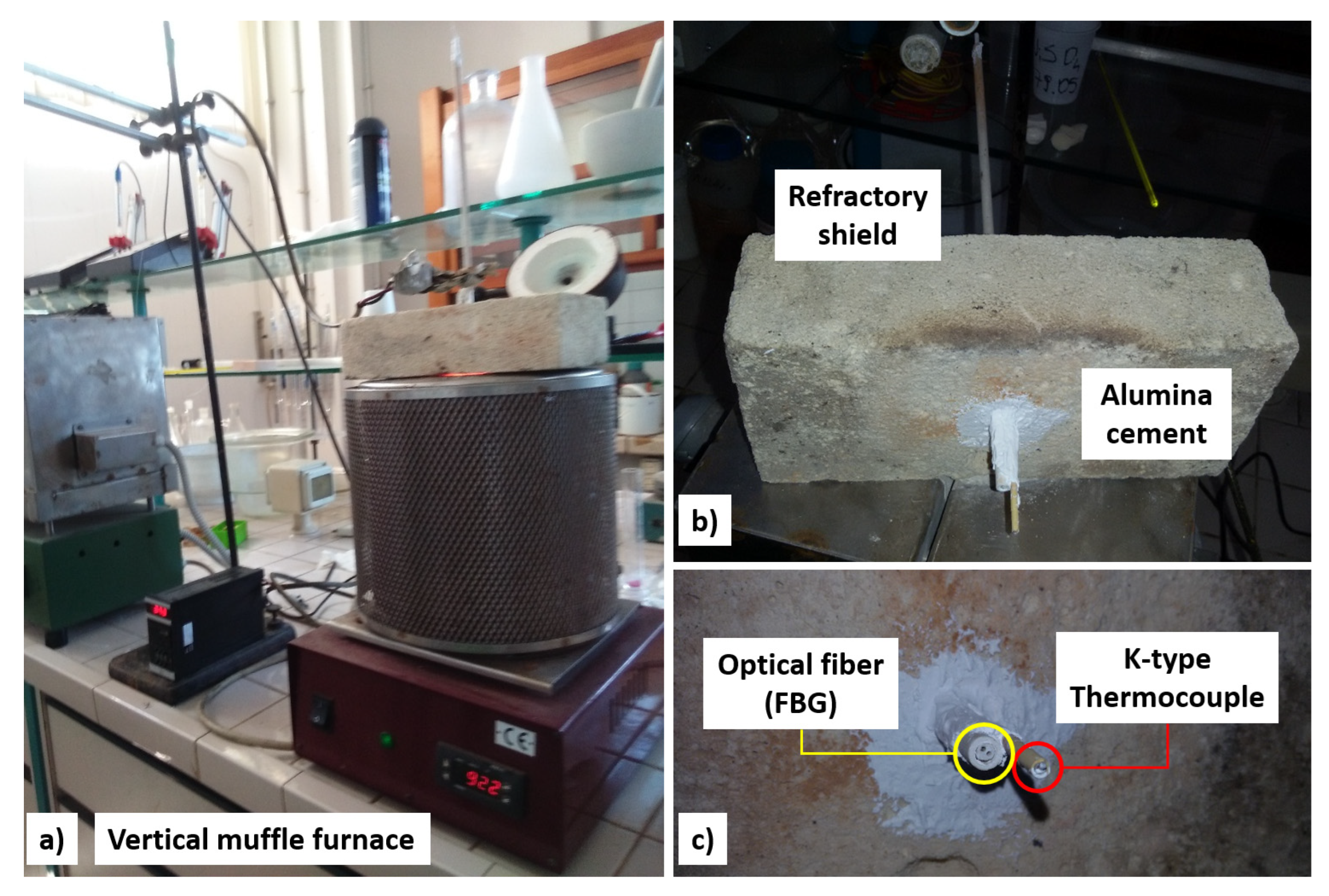
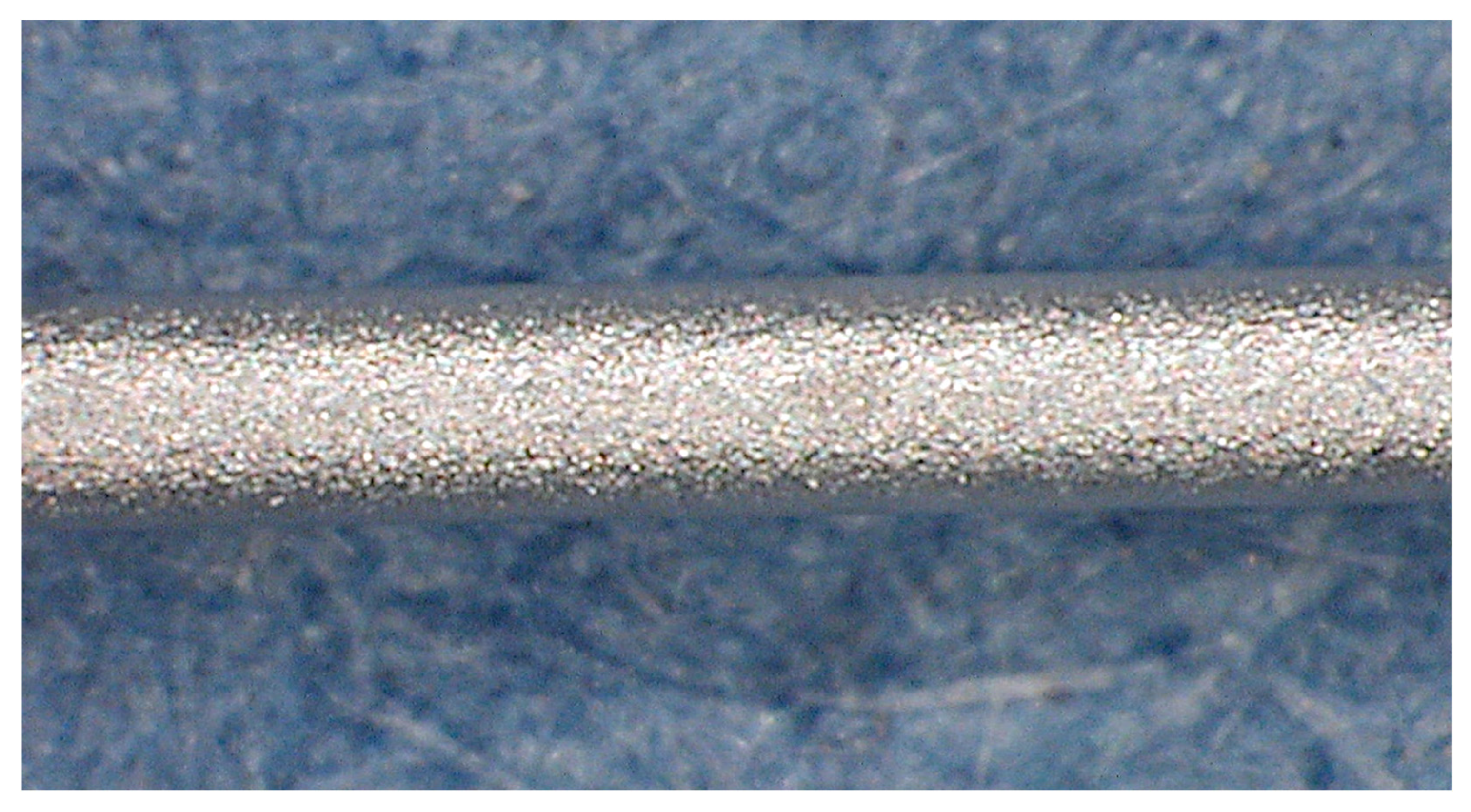

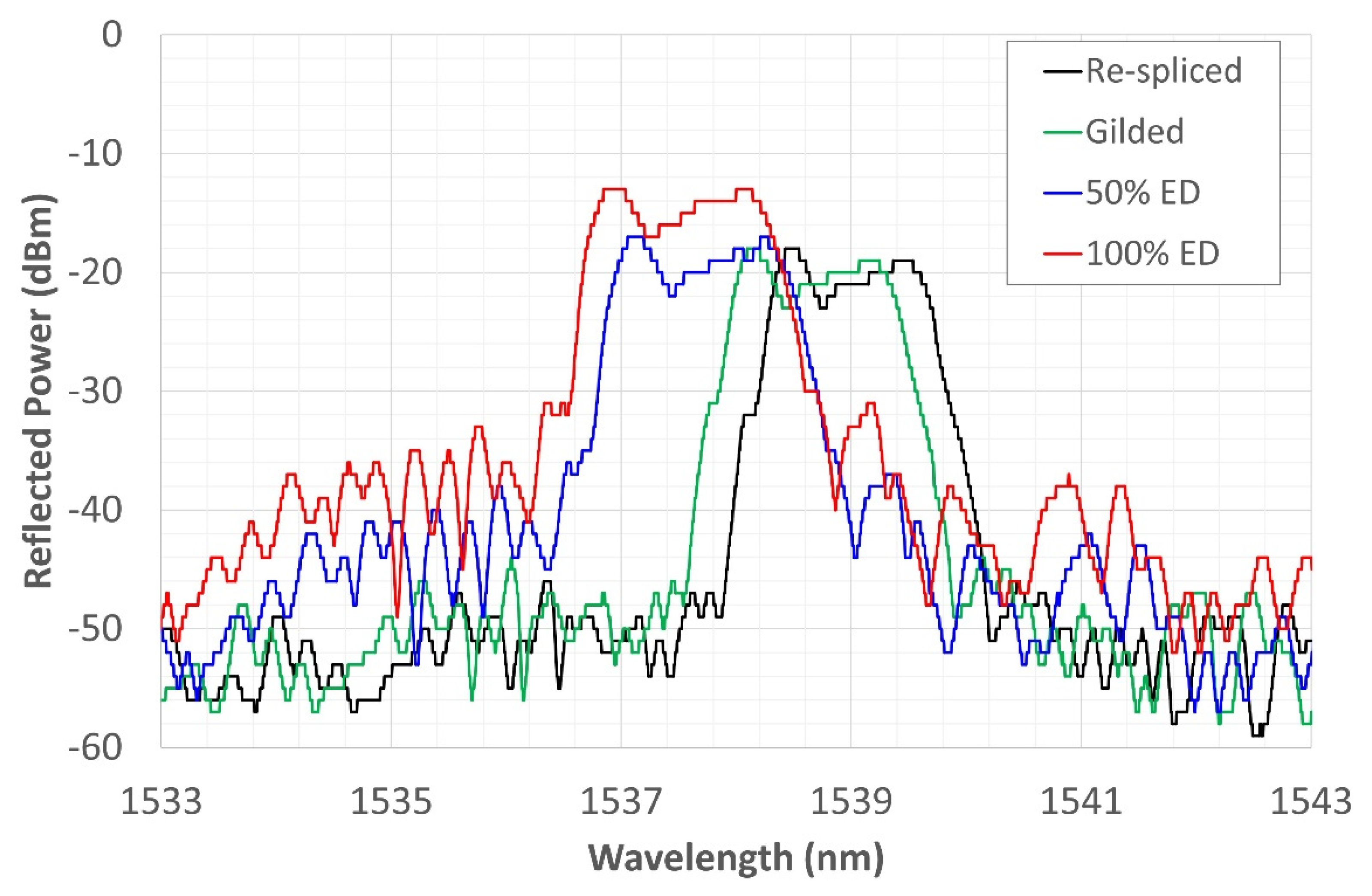
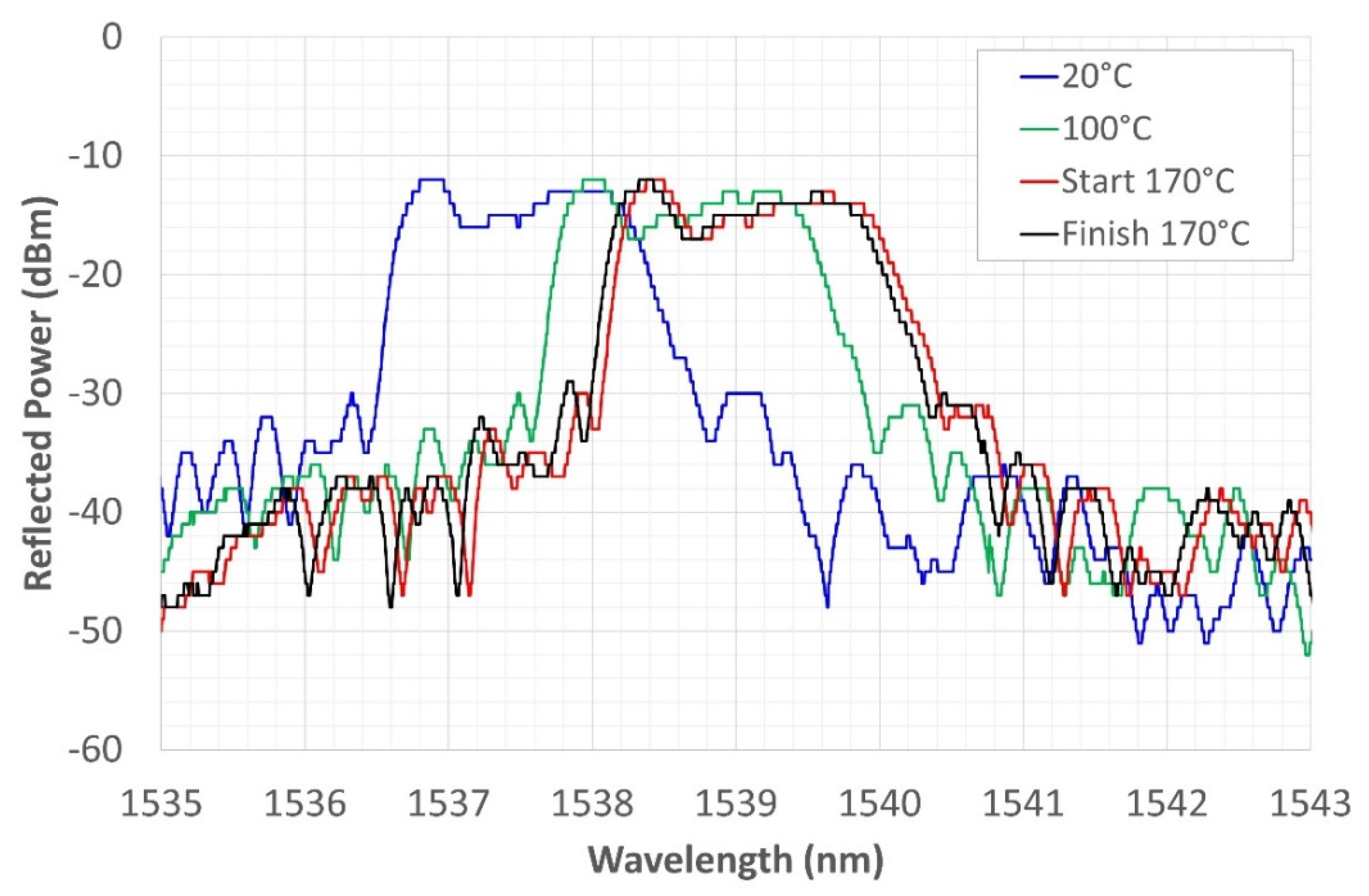




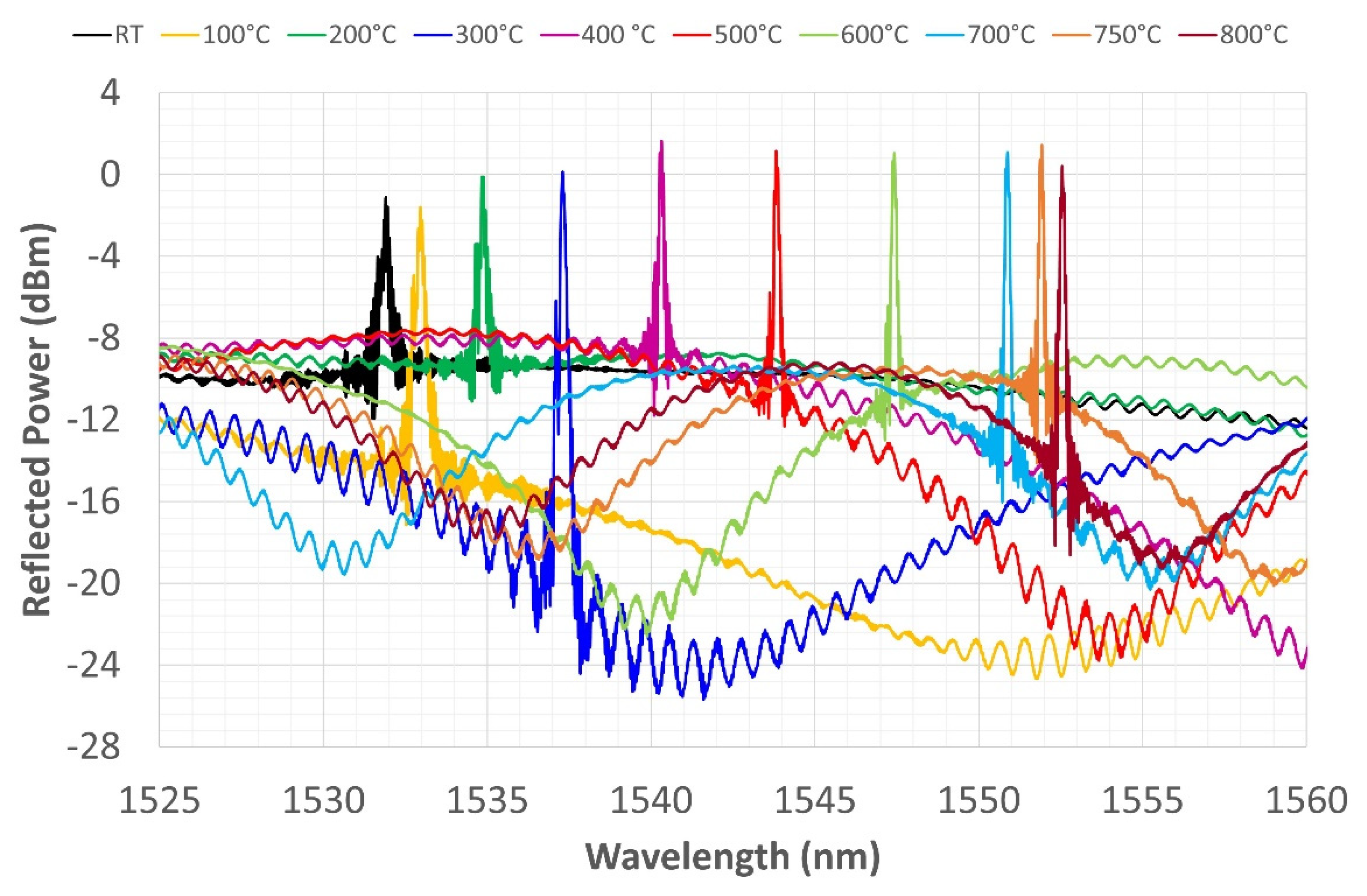


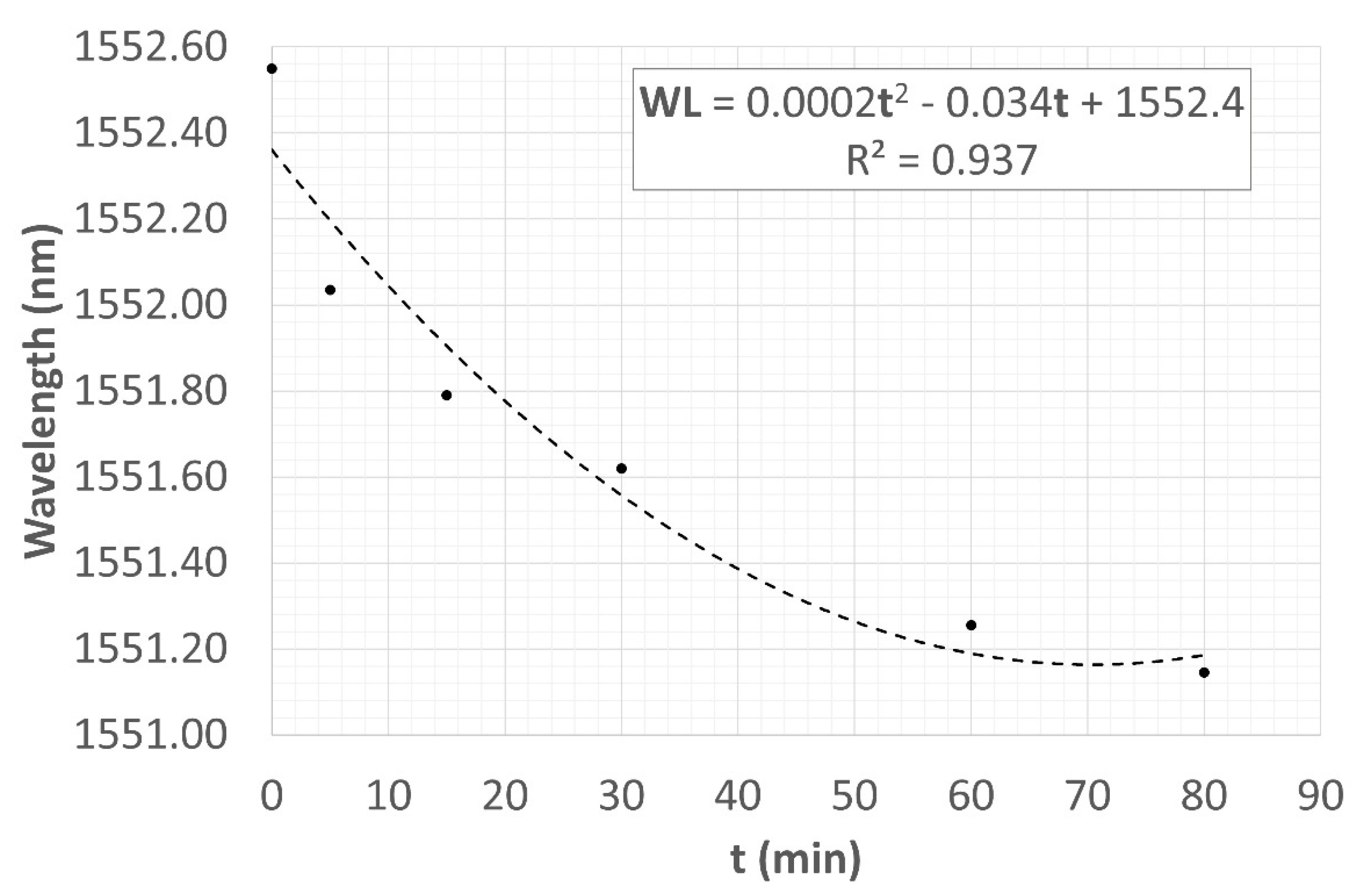
| Technique | Brief Explanation | Details | Ref. |
|---|---|---|---|
| Chemical composition grating (CCG) | Hydrogen-loaded FBGs are written in doped compounds capable of achieving thermal stabilization at temperatures above 1000 °C, while optical properties are altered (i.e., the presence of large-scale multiplexing and remote interrogation can occur). | [10,11,12] | |
| Tetrahedral FBG (TFBG) | Fibers are transformed from amorphous to tetrahedral-dominated microstructures. The modified fiber shows similar optical properties to conventional FBGs, but the tetrahedral microstructure shows a high thermal tolerance without losing grating and structural stability. | [13,14] | |
| Thermal-regenerated FBG (RFBG) | The thermal RFBG entails two typical steps: seed grating followed by isothermal or long-lasting treatment (annealing). A hydrogen loading is the first step prior to performing the seeding. The main scope of this technique is to thermally treat doped or conventional FBGs to stabilize the grating and work for high-temperature applications. |
| [15,16,17,18,19] |
| Thermal Stage | Temperature (°C) | Heating Conditions | Propose |
|---|---|---|---|
| Recovery | 170 | 2 °C/min | Dehydrogenation and stress elimination |
| I Thermal cycle | Evaluation of high-temperature effect on coating | ||
| Heating | 20–500 | 2 °C/min | |
| Cooling | 500–20 | ||
| II Thermal cycle | Evaluation of high-temperature effect on coating | ||
| Heating | 20–750 | 2 °C/min | |
| Cooling | 750–20 | ||
| III Thermal cycle | Evaluation of high-temperature effect on coating | ||
| Heating | 20–800 | 2 °C/min | |
| Cooling | 800–20 |
| t (Min) | WLExp (nm) | WLEst (nm) |
|---|---|---|
| 0 | 1552.550 | 1552.400 |
| 5 | 1552.035 | 1552.235 |
| 15 | 1551.790 | 1551.935 |
| 30 | 1551.620 | 1551.560 |
| 60 | 1551.255 | 1551.080 |
| 80 | 1551.145 | 1550.960 |
| 81 | - | 1550.958 |
| 82 | - | 1550.957 |
| 83 | - | 1550.956 |
| 84 | - | 1550.955 |
| 85 | - | 1550.955 |
| 86 | - | 1550.955 |
| 87 | - | 1550.956 |
| 88 | - | 1550.957 |
| 89 | - | 1550.958 |
| 90 | - | 1550.960 |
Publisher’s Note: MDPI stays neutral with regard to jurisdictional claims in published maps and institutional affiliations. |
© 2022 by the authors. Licensee MDPI, Basel, Switzerland. This article is an open access article distributed under the terms and conditions of the Creative Commons Attribution (CC BY) license (https://creativecommons.org/licenses/by/4.0/).
Share and Cite
Lupi, C.; Vendittozzi, C.; Ciro, E.; Felli, F. FBG Spectrum Regeneration by Ni-Coating and High-Temperature Treatment. Sensors 2022, 22, 7255. https://doi.org/10.3390/s22197255
Lupi C, Vendittozzi C, Ciro E, Felli F. FBG Spectrum Regeneration by Ni-Coating and High-Temperature Treatment. Sensors. 2022; 22(19):7255. https://doi.org/10.3390/s22197255
Chicago/Turabian StyleLupi, Carla, Cristian Vendittozzi, Erwin Ciro, and Ferdinando Felli. 2022. "FBG Spectrum Regeneration by Ni-Coating and High-Temperature Treatment" Sensors 22, no. 19: 7255. https://doi.org/10.3390/s22197255
APA StyleLupi, C., Vendittozzi, C., Ciro, E., & Felli, F. (2022). FBG Spectrum Regeneration by Ni-Coating and High-Temperature Treatment. Sensors, 22(19), 7255. https://doi.org/10.3390/s22197255








